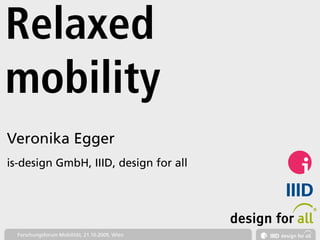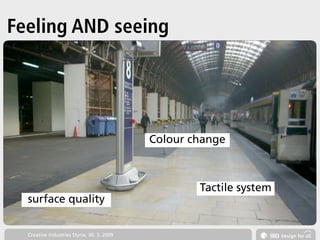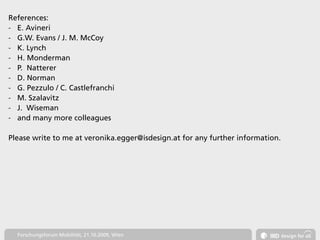Relaxed mobility
- 1. Relaxed mobility Veronika Egger is-design GmbH, IIID, design for all International Institute for Information Design Forschungsforum Mobilität, 21.10.2009, Wien
- 2. 1. How can we best incorporate all senses and experience in the design? 2. How can we improve the design process? Forschungsforum Mobilität, 21.10.2009, Wien
- 3. Interaction Information Environment Experiences User experience Expetations Decisions Design Quality Forschungsforum Mobilität, 21.10.2009, Wien
- 4. Knowledge Event Perception Experience A B C D Understanding Decision Action/reaction C2 B A D C Forschungsforum Mobilität, 21.10.2009, Wien
- 6. Perception - Sensory perception - Attention - First impressions (good/bad, pleasant/unpleasant) - Evaluation (important/unimportant, recognising patterns) Forschungsforum Mobilität, 21.10.2009, Wien
- 7. Information other senses 10% sehen, hören, hearing tasten 15% rational/controlled/ conscious vision 75% emotional/not controlled/ subconscious Information? Forschungsforum Mobilität, 21.10.2009, Wien
- 8. Sensory map rational/controlled/ conscious see close remote feel hear move taste smell emotional/not contolled/ subconscious Forschungsforum Mobilität, 21.10.2009, Wien
- 9. What we use rational/controlled/ in design conscious What we are missing see close remote feel hear move taste smell emotional/not contolled/ subconscious Forschungsforum Mobilität, 21.10.2009, Wien
- 10. Moving perception rational/controlled/ threshold through conscious design see feel hear close remote move smell taste emotional/not contolled/ subconscious Forschungsforum Mobilität, 21.10.2009, Wien
- 11. Vision - Clear image of our environment - Is dominant for conscious, intellectual pattern recognition, decisions, orientation - Is dominant for movement and balance - Changes in light intensity are connected to spatial/temporal impressions (day/night, inside/outside) Forschungsforum Mobilität, 21.10.2009, Wien
- 12. Hearing - We trust our ears more than our eyes - In case of a dissonance between hearing and vision the ear always wins - Not hearing or not understanding an announcement causes more stress than overlooking visual information - Changes in sound are connected to emotions (loud/quiet, urgency/calming) Forschungsforum Mobilität, 21.10.2009, Wien
- 13. Feeling - Touch receptors in the feet provide information about the composition and inclide of the floor - Tactile elements are information - Haptic properties tell stories about a surface - Feel the environment: temperature, air movement Forschungsforum Mobilität, 21.10.2009, Wien
- 14. Feeling AND seeing Farbveränderung Neigung Colour change Oberflächenbeschaffenheit Tactile system surface quality Forschungsforum Mobilität, 21.10.2009, Wien Creative Industries Styria, 30. 3. 2009
- 15. Feeling AND seeing colour change slant surface quality Forschungsforum Mobilität, 21.10.2009, Wien Creative Industries Styria, 30. 3. 2009
- 16. Feeling AND seeing Forschungsforum Mobilität, 21.10.2009, Wien Creative Industries Styria, 30. 3. 2009
- 17. Feeling, seeing, hearing use physical properties of the screen to provide tactile information Forschungsforum Mobilität, 21.10.2009, Wien Creative Industries Styria, 30. 3. 2009
- 18. Smell - Follow your nose – orientation by smell - Can evoke strong emotions - Normally we consciously take notice only of very positive or very negative smells Forschungsforum Mobilität, 21.10.2009, Wien
- 20. Experience - Intellectual comparison with similar experiences makes it easier to understand a new situation. - Body memory: remembering sensory experiences Forschungsforum Mobilität, 21.10.2009, Wien
- 21. Experience and information define expectations Information personal Expectation experience Event: Uncertainty, losing control stress Forschungsforum Mobilität, 21.10.2009, Wien
- 22. Does more or better information increase expectations? - In connection with little experience the expectations could be too high Forschungsforum Mobilität, 21.10.2009, Wien
- 25. http://www.smrt.co.kr/Train/Subwaymap/Eng/Subwaymap.jsp Forschungsforum Mobilität, 21.10.2009, Wien
- 27. Little excursion: control We prefer what we think we can control David Ropiek, Risk Consultant (Psychology Today) Forschungsforum Mobilität, 21.10.2009, Wien
- 28. Even if objectively this is more risky or not an advantage. „I can actively influence what‘s happening“ Forschungsforum Mobilität, 21.10.2009, Wien
- 29. Situations I am passively exposed to cause a heightened sense of stress. Announcements, running text (I can‘t re-visit, if I haven‘t heard/seen it, it‘s gone) Forschungsforum Mobilität, 21.10.2009, Wien
- 30. Loss of control makes people communicate When things don‘t go according to plan, a bus full of people suddenly start talking to each other. Forschungsforum Mobilität, 21.10.2009, Wien
- 31. Road traffic: built-in perceived risk increases attention. Lessens for public transport? Forschungsforum Mobilität, 21.10.2009, Wien
- 33. Understanding/recognition - Remembered experiences - Learned patterns and concepts (i.e. writing, sounds, surfaces) - Intuitive understanding/recognition as body memory - intuitive understanding of natural patterns (i.e. loud=urgent) Forschungsforum Mobilität, 21.10.2009, Wien
- 34. Legible buildings - Objects in the environment influence orientation behaviour – the largest object is the building itself - Users should be able to comprehend the building - Less signage and explanation, more implicitness (natural ractions) Forschungsforum Mobilität, 21.10.2009, Wien
- 35. Talking objects - Design should confirm expectations, an object should signal - Interaction is based on perceivable properties of the object - Signals to use natural patterns Forschungsforum Mobilität, 21.10.2009, Wien
- 36. I am an entrance I am heavy/light, open into the building, open I am a pane automatically .. of glass Schindler Award 2.7.2009, Wien
- 37. User experience Authenticity, harmony, aesthetics Atmosphere, consistency Look Feel interaction with environment Usability Functionality, predictability, usability, intellectual understanding Forschungsforum Mobilität, 21.10.2009, Wien
- 38. Improve user experience - Incorporating all senses - Use natural patterns Forschungsforum Mobilität, 21.10.2009, Wien
- 39. A „nudge“ in the right direction - It „feels right“ - Use gradual/sudden change to convey meaning - Use familiarity with object properties Forschungsforum Mobilität, 21.10.2009, Wien
- 40. From bi-sensory to multi-sensory principle - Don‘t focus on sensory deficits - Learn from sensory abilities of users Forschungsforum Mobilität, 21.10.2009, Wien
- 41. User Experience Design II „implicit communication“ for mobility, orientation and architecture Look Look Feel Implicit Feel comm. Usability Usability Forschungsforum Mobilität, 21.10.2009, Wien
- 42. Design process to reflect complexity 1. Early involvement of all key players: Users/custoemrs, organisation/provider, data and information services, architecture, maintenance ... 2. Interdisciplinary team 3. Joint definition of success criteria Forschungsforum Mobilität, 21.10.2009, Wien
- 43. Why define succes criteria? - The impact of design can be evaluated and measured – in terms of usability and monetary costs - Design as an integral part of the quality indicators of an organisation extends and ensures ownership Forschungsforum Mobilität, 21.10.2009, Wien
- 44. A guided, non-linear process User experience Accessability Performance criteria Key players Context Content Concept The company/ The team the organisation Design Technical briefing Framework Product/Service Forschungsforum Mobilität, 21.10.2009, Wien
- 45. Intuitive usability and measurable quality deliver an important contribution towards relaxed mobility – for users and providers Thank you. International Institute for Information Design Forschungsforum Mobilität, 21.10.2009, Wien
- 46. References: - E. Avineri - G.W. Evans / J. M. McCoy - K. Lynch - H. Monderman - P. Natterer - D. Norman - G. Pezzulo / C. Castlefranchi - M. Szalavitz - J. Wiseman - and many more colleagues Please write to me at veronika.egger@isdesign.at for any further information. Forschungsforum Mobilität, 21.10.2009, Wien













































